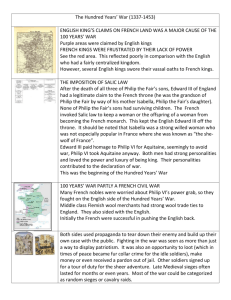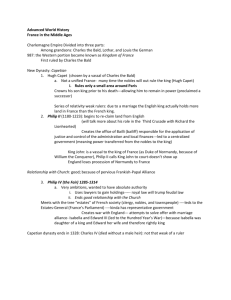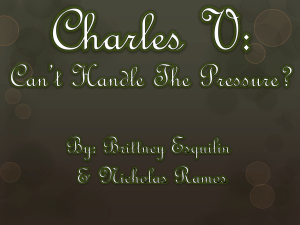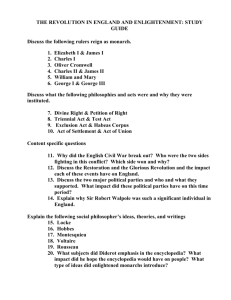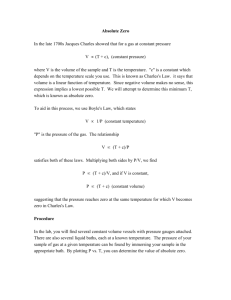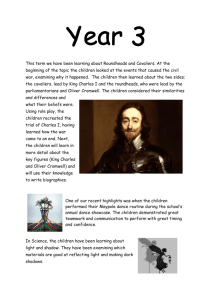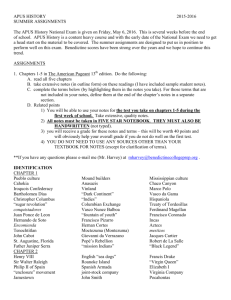Class 16 History 17t..
advertisement
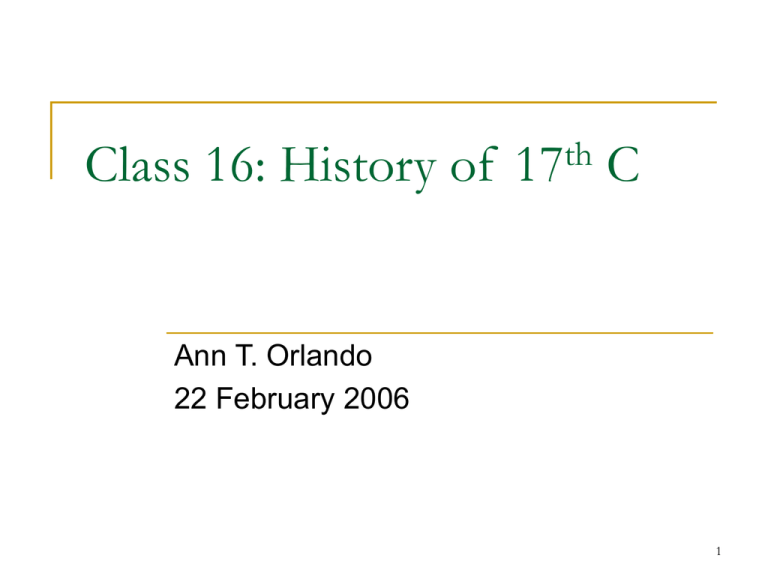
Class 16: History of th 17 C Ann T. Orlando 22 February 2006 1 Outline Where things stand politically c. 1600 Unfinished business: the Thirty Year’s War New Political Models Gallicanism 2 Spanish Empire c. 1600 Philip II (son of Charles V) died 1598 after ruling 40 years Philip III (son of Philip II, r. 1598-1621) Philip IV (son of Philip III, r. 1621-1665) Puts down revolt against Spanish rule in Netherlands Beginning of Thirty Year’s War End of Thirty Years War Charles II (son of Philip IV, r. 1665-1700) 3 England Henry VIII reigned 1509-1547 Mary I (Bloody Mary, Tudor), daughter of Henry and Catherine; 1531 declares himself head of Church Making her cousin of Emperor Charles V Returns England to Catholicism as official religion Marries prince Philip II of Spain (son of Charles V) Dies 1558 Elizabeth reigns 1558-1603 Return to Anglicanism Dies childless 4 England 1603-1660 James I, son of Mary Queen of Scots, succeeds childless Elizabeth Charles I, James son, reign 1625-1649 Cromwell and Puritans rule 1649-1660 Strong believer in Divine Right of Kings Married a Catholic Refused to compromise with Parliament over fiscal matters and revolt of Scotch Presbyterians King during English Civil War between English aristocracy (Anglicans) and Puritans led by Oliver Cromwell Charles I executed 1649 Disbanded official Parliament, and established parliament of saints in 1643 Attempt to implement ‘holy city’ model as in Geneva Brutal military oppression of Ireland After Cromwell’s death, Parliament asked king to return to return legitimacy to government 5 England 1660-1700 Restoration of monarchy, Charles II 1660-1685 Charles son, James II (1685-1688) Exhumed Cromwell’s body, desecrated it and through it into a common pit Persecution of Puritans Tolerance of Catholics; alliances with France Wants to return to Divine Right of Kings Even more strongly Catholic than Charles II Has his son baptized by Catholics William III and Mary II invited from Netherlands to rule England, Glorious Revolution Mary was James’ older Protestant daughter Married to Prince William of Orange Reigned 1679-1702 But Parliament retains great power; beginning of King as head of State rather than head of Government 6 France th 17 C Henry IV (r. 1584-1610) Edict of Nantes, 1598, granting toleration to Protestants Louis XIII (r. 1610 – 1643) Thirty Years War Louis XIV (Sun King) reigns 1643-1715 Becomes King at age 5; real power until older was Cardinal Richelieu Reduced power of nobility, increased power of throne Encouraged Gallicanism Absolute Monarch, period of stability and strength Revives (invents) French culture; Versailles center of France French Church sees itself as a national Church aligned with throne 7 Holy Roman Empire th 17 C Recall that Emperor is elected by German princes (electors) Recall that when Charles V resigns,1555, empire split in two Austria (including Hungary, southern Catholic German States) under Ferdinand I Spain and Low Countries under Philip II (husband of Mary Tudor) After Ferdinand, Holy Roman Emperor associated with Hapsburg rule in Austria Catholic Much dissent from Protestants in central Europe and Northern Germany Although Peace of Augsburg (1555) established cujus regio, ejus religio (whose reign, his religion) Friction continued Reduced need for protection against the Turks Led to Thirty Years War 8 Beginning of Thirty Years War War is really unfinished business from 16th C Holy Roman Emperor Rudolph II (r.1756-1612) Educated in Spain by Jesuits Issued many pro-Catholic directives But Emperor weak figure outside of Austria Rudolph decides to put down small Protestant revolts in Bohemia and northern Germany, 1608 Bohemians ask Frederick of Palatinate for help; but principality of Palatinate separated from Bohemia by staunchly Catholic Bavaria Rudolph successful, but leaves concerns across Europe that a reunited HRE and Spain could be stronger than ever In 1625 England, Netherlands, Denmark, Sweden join German Protestant states to form the Protestant League Rudolph was succeeded by is son, Ferdinand II; France joined Austria in fight 9 Map of Key Battles Thirty Years War www.rootsweb.com/~wggerman/map/thirtyyear.htm 10 Ravages of Thirty Years War Very brutal war; attacked civilians as well as soldiers Thirty Years of War led to destruction of much of central Europe and northern Germany Ends in 1648 with Treaty of Westphalia Reaffirms Peace of Augsburg France extended territory to Rhine Sweden received lands in Baltic German princes somewhat stronger Austrian power reduced 11 Result of War Every country in Europe affected in some way Led to disillusionment with religion in general Begins time of questioning role of religion in government Rise of atheism as a viable, allowable belief 12 Beginning of Different Models of Political Theory If religion not a good source of political cohesion, then what is Two answers are developed in 17th C Hugo Grotius (1583-1645) developed natural law theory of relations within and among nations; went back to Roman stoicism Bishop Jacques Bossuet (1627-1704) develops divine right of kings concept; king is God’s vicar on earth; went back to feudal system Divine right of kings increasingly becomes answer in France, Spain, Austria, Sweden England starts to develop natural law political philosophy (John Locke) For the first time can start to really talk about separation of religion and politics (if not church and state) Beginning of modern nation states 13 Papacy in th 17 C Recall that Trent had affirmed a strong papacy But rising nationalism, especially in Catholic countries where divine right of kings was gaining support undercut Papal political authority Popes in 17th C were not very strong France refuses to accept much of Trent Investiture controversies of Middle Ages revisited 14 Gallicanism vs. Ultramontanism France over the centuries had a complex relationship to Papacy, saw herself as the ‘eldest daughter of the Church’ Pepin Short (8th C) Philip the Fair vs Boniface VIII Avignon Papacy Conciliarism Henry IV and his successors refused to accept Trent decrees on Papal appointment of bishops; known a Gallicans Much of the clergy, thanks to Jesuit education, was in favor of Trent; Ultramontanes (beyond the mountains) Much of the Trent reforms were observed in practice 15 Louis XIV vs Pope Innocent XI Louis XIV, very strong force in Europe, pressed for even more control over French bishops under his Divine Right of Kings Innocent XI threatened to excommunicate Louis XIV Louis called Assembly of Clergy, 1681-1682, chaired by Jacques Bossuet, led to Four Articles Church property Election of Bishops Pope has no authority over temporal affairs Reasserted Council of Constance Papal decrees could only be accepted if accepted by whole Church Rejected Papal infallibility separate from Pope After death of Innocent XI in 1689, compromise was reached: Four Articles not taught in French schools; Pope recognized divine right of French kings; infallibility side-stepped Ultramontanism vs Gallicanism will remain a divisive issues in French Church until Vatican I 16

